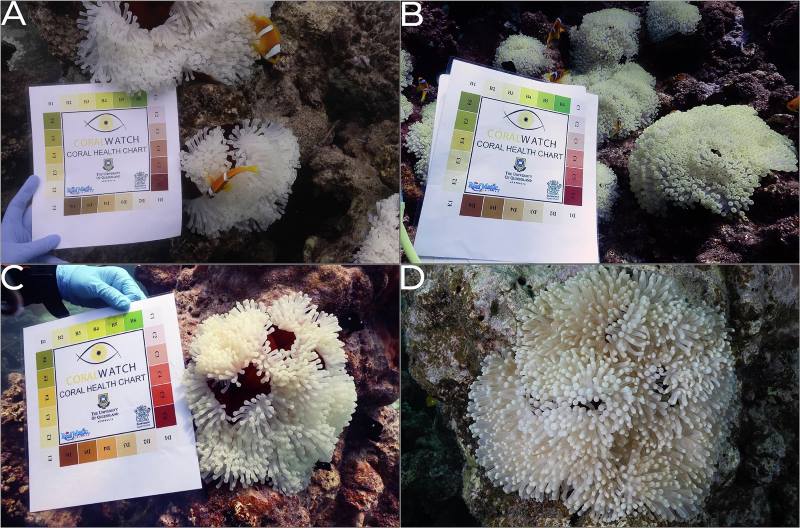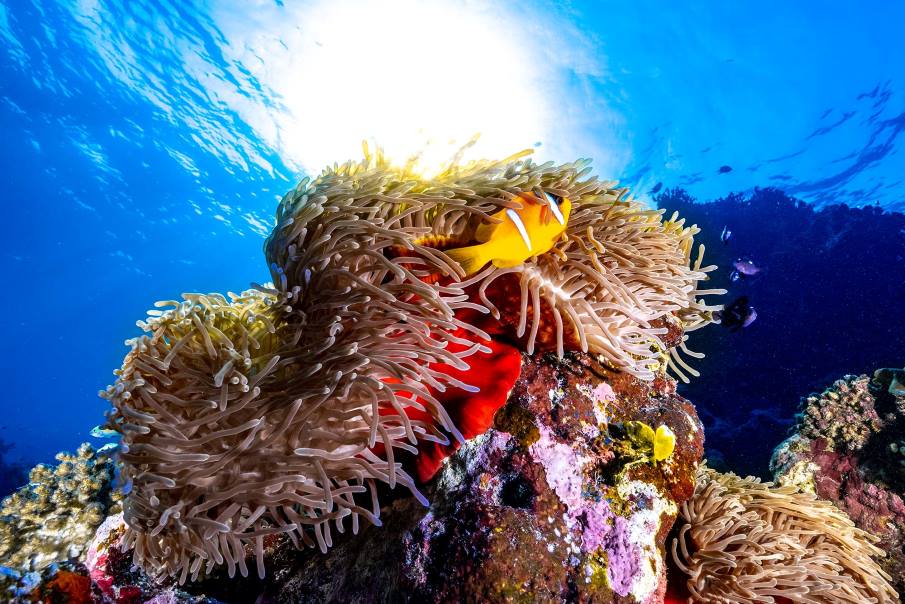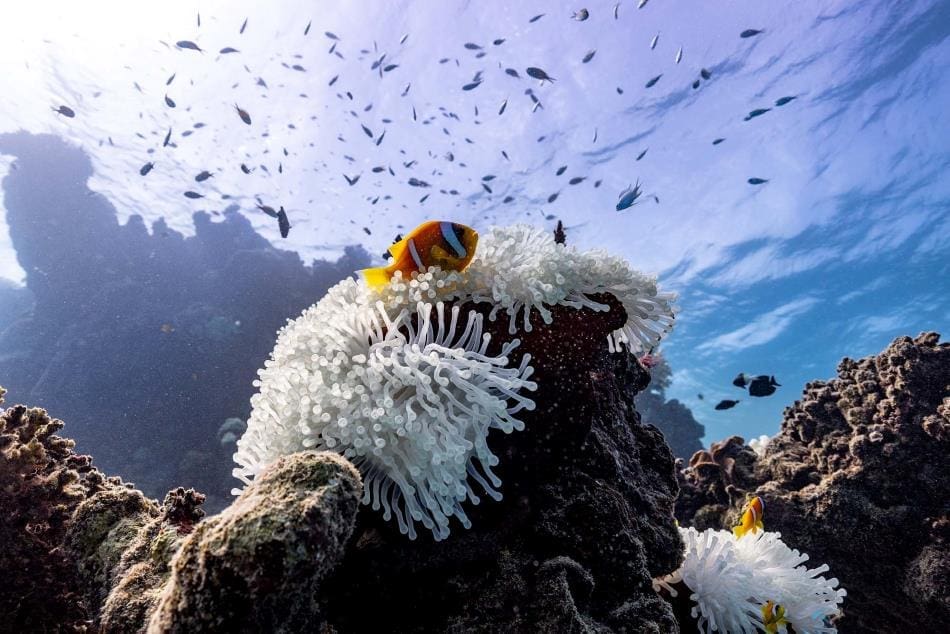Summary:
Rising ocean temperatures in the Red Sea are driving the collapse of one of the ocean’s most iconic partnerships: clownfish and sea anemones. A new study published in npj Biodiversity and led by marine biologists from Boston University reveals that recent marine heatwaves have devastated populations of Amphiprion bicinctus (Red Sea clownfish) and their host anemones Radianthus magnifica on three reefs off central Saudi Arabia.
The researchers monitored the reefs from 2022 to 2024, including a 2023 heatwave that reached a peak of around 22 °C-weeks in Degree Heating Weeks, and recorded near-total mortality. They observed 100 percent bleaching of anemones, 94–100 percent clownfish mortality, and 66–94 percent anemone mortality. Under normal conditions, the two species depend on each other for protection and nutrients, but extreme heat disrupts this mutualism by causing the anemones to bleach – expelling their symbiotic algae and losing their color and stinging ability.
The team warns that this breakdown leaves clownfish exposed to predators and could drive local, and possibly regional, extinction. The Red Sea has long been seen as a potential refuge from climate change because of its naturally high temperatures, but the study shows that even this region is no longer insulated from its effects.

Clownfish and anemones are disappearing because of climate change
The Red Sea, circled by desert landscapes, is home to marine life accustomed to the water’s bathtub-like temperatures – often reaching 85 to 90 degrees Fahrenheit in the summer. But in the past three years, marine heat waves have made the Red Sea even hotter. Rising ocean temperatures, there and around the world, have been devastating for many sea creatures, including an iconic ocean duo: clownfish and anemones.
A new paper from a Boston University–led research team finds that this extreme heat has caused a breakdown in the mutualistic relationship of clownfish – also called anemonefish – and anemones and has resulted in a population collapse in the central Red Sea.
This pair forms one of the most widely recognized mutually beneficial relationships in the ocean – thanks to Finding Nemo. They’re adapted to work as a team to get nutrients and for protection. Anemones also have a symbiotic relationship of their own – with a microscopic algae called zooxanthellae, the same algae that pairs with coral. Just like corals, anemones expel their symbiotic algae from their tissue during periods of unusually high heat, causing them to bleach. The researchers found that prolonged bleaching can not only lead to the death of the anemone and the anemonefish, but collapses the entire mutualistic system.
“We always hope that anemones and clownfish groups survive bleaching events, as they have over and over again in the last 10 years, but it hit a point where it was too extreme,” says Morgan Bennett-Smith (GRS’25,’27), a PhD candidate in BU’s Marine Evolutionary Ecology Laboratory and lead author of the paper. He has studied anemones in the Red Sea for the last decade and has witnessed firsthand how exceedingly high temperatures have pushed the anemones and clownfish past the temperature threshold they can tolerate.

The research, which started when Bennett-Smith was studying at King Abdullah University of Science and Technology in Saudi Arabia, focused on Red Sea clownfish (Amphiprion bicinctus) and their host sea anemones (Radianthus magnifica) on three central Saudi Arabian Red Sea reefs from 2022 to 2024 – coinciding with a 2023 marine heatwave. According to Bennett-Smith, the monitored anemones were bleached for about six months during that time. As a result, the paper estimates that 94 to 100 percent of the clownfish died, and 66 to 94 percent of the anemones.
“It’s especially painful because the Red Sea is a place many researchers have been hoping and hypothesizing is a thermal refuge,” he says, meaning that organisms there would be protected from the impacts of climate change due to its location and already hot temperatures. “The fact that even this thermal refugium is collapsing in different ways is especially horrific. It’s not turning out to be the safe haven we thought it was.”
To a clownfish, anemone bleaching is a catastrophe – their once safe home turns white, exposing them to dangers lurking in the surrounding reef. Under normal conditions, clownfish are camouflaged and protected underneath the swaying, stinging tentacles of an anemone, which are related to jellyfish. The clownfish secrete a mucus that shields them and their eggs from getting stung, so when they attract a predator fish to the anemone, it gets zapped and eaten.
Human-caused climate change has heated the ocean to new extremes, and has started to unravel the mutualistic relationships that sustain underwater environments, like those between algae and corals, algae and anemones, and anemones and clownfish.
“Historically, anemones have bleached relatively little compared to corals, but now we’re getting up to levels where the anemones are bleaching, and that results in a catastrophic breakdown in the mutualism with the anemonefishes that everybody knows and loves,” says Peter Buston, a BU College of Arts & Sciences associate professor of biology,one of the senior authors on the paper. “We’re seeing nearly a 100 percent die-off in a population of fish in response to a heating event,” says Buston, who leads the Marine Evolutionary Ecology Laboratory. “This should be a big warning for ourselves as well.”
From the Wild to the Lab
Bennett-Smith didn’t set out to study anemone bleaching or the effects of climate change (he was interested in studying the mutualism between anemones and other sea creatures), but he was intrigued when he first observed a bleached anemone in the Red Sea in 2018. At the time, it was an extremely uncommon occurrence. “Since then, year after year, we keep running into worse and worse bleaching events,” he says. Now it’s the main theme of his research at BU. In Buston’s lab, Bennett-Smith and a team of BU students are investigating these dynamics to identify what exactly is causing the population declines.

“We’re interested in figuring out why the fish disappear and die shortly after the bleaching occurs,” says Buston, who is also CAS associate dean of the faculty for the natural sciences. “This mutualism is protecting the fish from predation, so what is happening post-bleaching that leaves the fish exposed? We have a suite of hypotheses that we’re testing in the lab.”
Their first hypothesis is that the fish become more conspicuous – these bright orange fish get exposed against an unnatural white background. They’ve also found that the behavior of the fish changes when their anemones bleach, with more of the clownfish getting into conflicts that leave smaller fish outside of the anemone. The team, in collaboration with colleagues at Harvard University, has also done preliminary testing on the anemones’ stinging cells and found that they don’t fire as well when bleached. In the lab, they’re able to mimic the conditions that lead to bleaching, and study the effects up close.
“There’s a lot going on; increased conspicuousness, increased time outside of the anemones, increased conflict between the fish, and reduced protection from the anemones,” Buston says. “These anemonefish become sitting ducks. They’re not great swimmers and don’t stray from their anemones, so they presumably get taken off by predators.”
Even if wild anemones recover from the bleaching, once the anemonefish are gone, they become much more vulnerable to their own predators, like butterflyfish, who feed on anemones.
“Anemones aren’t as well studied compared to coral, so there’s a lot to unravel,” Bennett-Smith says.
As a continuation of the work in the Red Sea, the team will soon be reporting on similar heating events off the coast of Papua New Guinea, where the bulk of Buston’s research is done. His students travel there multiple times a year to study different aspects of the anemonefish life cyle – like parental care, growth changes, and other dynamics in the small fish colonies.
The anemones in the waters of Papua New Guinea have also experienced heating events and bleaching, resulting in noticeable declines and changes to the clownfish. Earlier this year, Buston, Bennett-Smith, and collaborators from Newcastle University in the United Kingdom found that a wild population of clownfish in Papua New Guinea shrink to survive heat stress.
“I’ve studied anemonefishes for a long time, and unavoidably, I and all my students now study them in the context of climate change,” Buston says. “You get enough of these local extinction events, and it ultimately leads to complete extinction.”
Losing these important species has cascading effects on the reef, their paper on the Red Sea points out. The authors call for surveys in other regions of the Red Sea, as well as worldwide, to evaluate their conservation status at large. The hope, according to Bennett-Smith, is that local experts can strengthen conservation and restoration efforts to protect the areas in need, before it’s too late.
Journal Reference:
Bennett-Smith, M.F., Villela, H., Justo, M.S.S. et al., ‘Near complete local extinction of iconic anemonefish and their anemone hosts following a heat stress event’, npj Biodiversity 4, 35 (2025). DOI: 10.1038/s44185-025-00107-4
Article Source:
Press Release/Material by Jessica Colarossi | Boston University
Featured image credit: Morgan F. Bennett-Smith



